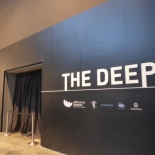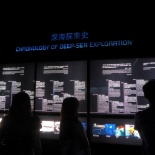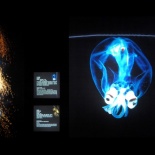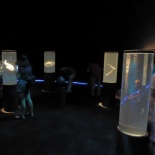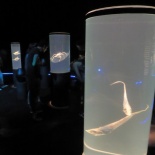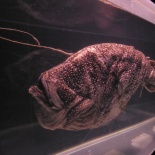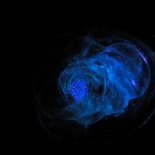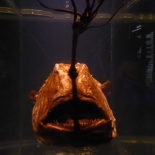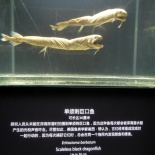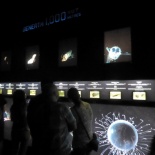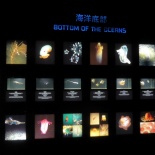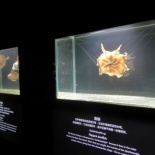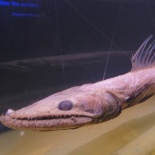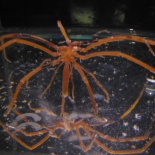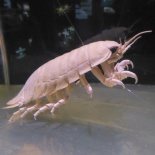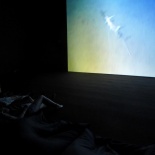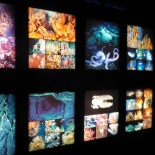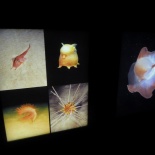– Dr. Cindy Lee Van Dover
If you like exploring the creatures of the dark unknown, “The Deep” is a natural history exhibition held at the Art Science Museum Singapore showcasing creatures of the deep sea. The sea and oceans covers 71% Earth surface. However, despite it being the largest reservoir of life, it still remains largely unexplored by Man. In-fact, less than 10% of the seafloor has been mapped and known to civilisation to date, we actually know less of what resides within the depths of our oceans than we do of our planetary Moon.
Curated by Claire Nouvian, the author of the similarly named “The Deep” book, the Deep exhibition presents the largest collection of over 40 deep-sea creatures seldom seen by man and displayed for the first time in Southeast Asia through eight exhibition zones. To give visitors a feel of the abyss, the exhibition is set in a completely dark, and near pitch black environment, virtually immersing you into the realms of the deep. The first gallery comprise of a timeline the history of deep sea exploration till today, giving your eyes time to adjust and adapt to the sudden change in darkness.
Hidden Depths Multi-Media Installation
The Hidden Depths is an immersive multi-media installation which follows as a second gallery. It is an interactive installation brought to you by Lynette Wallworth from Australia. Scattered around the arena are cylindrical glass installations housing preserved deep-sea specimens. A sense of mystery shroud the objects presented to you. Grab a UV LED torch, explore the space and take a peek inside few of the several earthen pots (Made by Singapore’s Mudrock Ceramics master potters) littered around, lighting up bio-luminescent glass sculptures or view Video footage of bio-luminescent marine creatures, fluorescent proteins (brought to you by Marine biologist Steve Haddock and Dr Anya Salih) and ambient audio from NASA.
The exhibition carries on into separate galleries showcasing more unique specimens, including a large giant anglerfish, complete with its bioluminescent “headlamp” it uses to lure prey in the dark. The specimens presented in exhibition are extremely rare, seldom seen by man; and seem to reside from a completely different ecosystem altogether (which is actually true). They are most of the time unrecognizable from the conventional surface marine creatures we come to know. Most of these fragile abyssal creatures were either fished from exploration vessels or carefully trawled during global oceanographic missions or retrieved from commercial fisherman by-catches during deep-sea trawling.
Adaptations of deep sea creatures
From there, the exhibition dives visitors deeper into the sea of unknown through different themed zones depicted by difference in oceanic depths, starting with life 1000m under sea-level, to the mid-water wildlife 4000m under and eventually life right on the bottom of the ocean floor.
The specimens on display at each of the given depth reveal natural and unique adaptations to feed and survive in the dark, yet hostile environments of the deep. Given the complete lack of sunlight from a 1000m depth onwards, anything which exists beyond these depths are only animals and minerals. As such, many of these creatures such as fishes, cephalopods and crustaceans resort to bio-luminescent to hunt and transparency to evade. In place of sunlight, ocean floor volcanoes create flourishing deep-sea ecosystems through bacteria, which unlike the ecosystem we know, sustains the food chain above it in the complete absence of plants and sunlight.
I particularly enjoyed the exhibition revealing the lurking mysteries of the deep through displays of well-preserved and extremely rare animals in perfect detail, offering a reflection not only on the diversity of marine species but the vast depths yet remain to be explored. Some of my favorite specimens includes the classic Anglerfish, the rather adorable Grimpoteuthis Dumbo Octopus (one of the fourteen species) and the sea-spider (which resembles a stick-like insect. The sea spider shares more similarities with our crustaceans friends, where they spend most of their time resting on the bottom of the ocean floor.
The accompaniment by artwork, photos and video showcase of captivating sea fauna and ethereal luminescent creatures, such as bio-luminescent squid and phosphorescent algae, some never photographed before was a true explorer’s joy. The final exhibition zone is an open area dedicated to Claire Nouvian and her efforts to raise public awareness of the fragility of the deep sea ecosystem and urgency to protect and preserve the fragile ecosystem of the deep, complete with children activity areas.
“The Deep” exhibition will take about 2 hours to complete in total and is currently held at the Art Science museum, Singapore running from 30th March 2015 to 27th October 2015. Tickets are priced at $14 for adults (Discounted to $11 for Singaporeans with a valid NRIC) I will recommend the more value for money to grab an all-access day-ticket to view a concurrent exhibition there- perfect for a museum day out for all ages.
Happy exploring! (if the displays don’t disgust you).
View more photos of the exhibition here.

